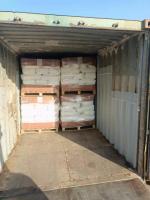Our Products
Polyacrylamide / Anionic polyacrylamide arifloc c606 can be replaced by Chinafloc A2517

Introduction
Anionic polyacrylamide (APAM) is a water-soluble polymer widely used in industrial and municipal processes for solid–liquid separation. Arifloc C606, a commercial grade of anionic polyacrylamide, is formulated with specific molecular weight and anionic charge density to perform effectively in wastewater treatment, mineral processing, paper production, and various chemical operations. Its mechanism of action is based on adsorption, charge neutralization, and bridging flocculation, which allows suspended particles, colloids, and fines to aggregate into larger flocs that settle or filter out more easily.
The versatility of Arifloc C606 comes from its ability to adapt across industries with varying water chemistries and solid compositions. Below is a comprehensive discussion of its applications.
1. Water and Wastewater Treatment
a. Municipal Sewage Treatment
In municipal treatment plants, sewage contains suspended solids, organic matter, and colloids that are difficult to remove through simple sedimentation. Arifloc C606 enhances the flocculation and settling of these particles when used in primary clarification and secondary treatment stages. By binding negatively charged suspended solids into larger flocs, it accelerates settling, improves effluent clarity, and reduces turbidity.
In sludge dewatering, Arifloc C606 is used prior to centrifuges, belt presses, and filter presses. It helps water separate from sludge solids, producing a drier cake and reducing disposal costs.
b. Industrial Wastewater
Industries such as food processing, dairy, brewery, pulp and paper, and textiles discharge wastewater rich in suspended solids, fats, and oils. Arifloc C606 is highly effective in treating these streams. For example:
-
In textile wastewater, it removes color and suspended particles.
-
In dairy processing, it improves the separation of fats and protein-rich waste solids.
-
In chemical effluents, it enhances clarification by neutralizing complex colloids.
2. Drinking Water Treatment
In potable water treatment plants, coagulation and flocculation are crucial steps. While inorganic coagulants like alum or ferric chloride neutralize charges, they often produce weak and slow-settling flocs. Arifloc C606, when used as a flocculant aid, forms strong, larger flocs that settle faster and resist shear. This improves sedimentation, sand filter performance, and reduces residual turbidity in the treated water.
3. Mining and Mineral Processing
Anionic polyacrylamide is a cornerstone chemical in mineral beneficiation and tailings management. Arifloc C606 is particularly valuable in:
a. Tailings Dewatering and Thickening
Mining operations generate large volumes of fine tailings, which are difficult to settle. Arifloc C606 accelerates sedimentation in thickeners, producing clear overflow water for recycling and dense underflow for disposal or paste backfill.
b. Coal Washing
In coal preparation plants, fine coal slimes are difficult to separate from water. Arifloc C606 improves the settling of coal fines, enhances recovery, and reduces water loss in tailings.
c. Metal Mining
In processing ores such as copper, gold, and bauxite, Arifloc C606 is applied in clarification circuits to improve recovery efficiency and ensure water recycling. Its high molecular weight makes it effective for large-particle bridging and settling.
4. Paper and Pulp Industry
Arifloc C606 serves multiple functions in papermaking:
-
Retention Aid: It helps retain fillers like kaolin, titanium dioxide, and calcium carbonate on fibers, improving paper quality and reducing raw material loss.
-
Drainage Aid: It enhances water removal on the paper machine, increasing production efficiency.
-
Wastewater Treatment: The industry generates effluents containing fibers, lignin, and fillers. Arifloc C606 promotes flocculation of these suspended solids, enabling easier clarification and recovery of process water.
5. Oil and Gas Industry
Though cationic flocculants are often favored in oil–water separation, anionic polyacrylamide like Arifloc C606 is used in certain operations:
-
Drilling Fluids: As a viscosity modifier and fluid loss reducer in water-based drilling muds.
-
Produced Water Clarification: In combination with coagulants, it helps remove suspended solids from water produced alongside oil.
-
Fracturing Operations: It can be used as a friction reducer in hydraulic fracturing fluids, reducing pumping pressures and improving fluid transport.
6. Agriculture and Soil Conditioning
Arifloc C606 improves soil structure and water infiltration. When applied to irrigation canals or agricultural soils, it reduces erosion by binding soil particles together, preventing surface sealing and runoff. This application is particularly valuable in arid regions where water conservation is critical.
7. Textile and Dyeing Industry
In dyehouses, wastewater is characterized by high color content and chemical oxygen demand (COD). Arifloc C606 helps by:
-
Aggregating dye molecules and suspended solids.
-
Enhancing decolorization efficiency when combined with coagulants.
-
Improving sludge settling and reducing secondary pollution.
8. Construction and Tunneling
In construction and tunneling, bentonite slurries are often used as drilling support fluids. These slurries require clarification and recycling. Arifloc C606 is applied to accelerate settling of fine clays, enabling the reuse of bentonite or disposal of cleaner water.
9. Environmental Applications
Arifloc C606 is employed in river and lake restoration projects to reduce turbidity and remove suspended clays. By promoting rapid flocculation, it clears water bodies and supports aquatic ecosystem recovery.
It is also used in stormwater treatment, where runoff carries fine sediments and organic matter. The polymer helps sediment basins achieve higher clarity before discharge.
Advantages of Arifloc C606
-
High Efficiency: Capable of treating very low concentrations of suspended solids.
-
Broad Compatibility: Works with a variety of coagulants (alum, PAC, ferric salts).
-
Flexibility: Can be used in batch, continuous, or high-rate treatment systems.
-
Environmental Impact: Non-toxic at recommended dosages and contributes to water recycling and conservation.
-
Economic Benefits: Reduces chemical consumption, improves sludge handling, and lowers energy costs in downstream processes.



836_small.jpg)
559_small.jpg)